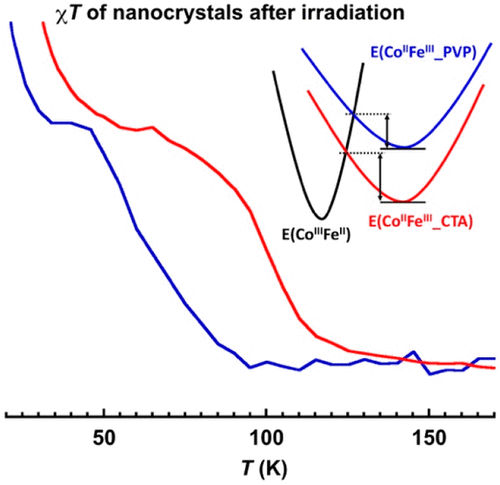当前位置:
X-MOL 学术
›
Inorg. Chem.
›
论文详情
Our official English website, www.x-mol.net, welcomes your
feedback! (Note: you will need to create a separate account there.)
Photoswitchable 11 nm CsCoFe Prussian Blue Analogue Nanocrystals with High Relaxation Temperature.
Inorganic Chemistry ( IF 4.3 ) Pub Date : 2020-08-28 , DOI: 10.1021/acs.inorgchem.0c01432 Linh Trinh 1 , Serhane Zerdane 2 , Sandra Mazérat 1 , Nada Dia 1 , Diana Dragoe 1 , Christian Herrero 1 , Eric Rivière 1 , Laure Catala 1 , Marco Cammarata 2 , Eric Collet 2 , Talal Mallah 1
Inorganic Chemistry ( IF 4.3 ) Pub Date : 2020-08-28 , DOI: 10.1021/acs.inorgchem.0c01432 Linh Trinh 1 , Serhane Zerdane 2 , Sandra Mazérat 1 , Nada Dia 1 , Diana Dragoe 1 , Christian Herrero 1 , Eric Rivière 1 , Laure Catala 1 , Marco Cammarata 2 , Eric Collet 2 , Talal Mallah 1
Affiliation

|
Photoswitchable 11 nm nanocrystals with the coordination network Cs{Co[Fe(CN)6]} were obtained using a template-free method. The nanocrystals were recovered from the colloidal solutions as solid materials surrounded by cetyltrimethylammonium (CTA) cations or embedded in the organic polymer polyvinylpyrrolidone (PVP). Complementary magnetic, spectroscopic, and structural techniques, including EPR spectroscopy, reveal a majority (∼70%) of the low-spin and photoactive diamagnetic CoIIIFeII pairs located in the core of the nanocrystals and a mixture of CoIIFeII and CoIIFeIII species present mainly within the shell of the objects. While bulk compounds with similar vacancy concentration do not exhibit noticeable photoinduced charge transfer, the observed photoactivity of the nanocrystals is ascribed to their nanometric size. The relaxation temperature of the photoinduced state shifts upward by ∼55 K when PVP is replaced by CTA. This is ascribed to the larger rigidity of the dense CsCoFe_CTA material, whose metastable state is lower than that for CsCoFe_PVP, leading to a larger relaxation energy barrier and, therefore, to a higher relaxation temperature.
中文翻译:

具有高弛豫温度的光开关11 nm CsCoFe普鲁士蓝类似物纳米晶体。
使用无模板方法获得具有配位网络Cs {Co [Fe(CN)6 ]}的可光开关的11 nm纳米晶体。从胶体溶液中回收纳米晶体,将其作为被十六烷基三甲基铵(CTA)阳离子包围或嵌入有机聚合物聚乙烯吡咯烷酮(PVP)中的固体材料。互补的磁性,光谱和结构技术,包括EPR光谱,揭示了位于纳米晶体核心的大部分低自旋和光敏抗磁Co III Fe II对(约70%)以及Co II Fe II和Co II的混合物。钴二铁三物种主要存在于物体的外壳内。尽管具有相似空位浓度的本体化合物没有表现出明显的光诱导电荷转移,但观察到的纳米晶体的光活性归因于其纳米尺寸。当用CTA代替PVP时,光诱导态的弛豫温度向上移动约55K。这归因于致密的CsCoFe_CTA材料的更大的刚性,该材料的亚稳态低于CsCoFe_PVP的状态,从而导致更大的弛豫能垒,因此导致了更高的弛豫温度。
更新日期:2020-09-21
中文翻译:

具有高弛豫温度的光开关11 nm CsCoFe普鲁士蓝类似物纳米晶体。
使用无模板方法获得具有配位网络Cs {Co [Fe(CN)6 ]}的可光开关的11 nm纳米晶体。从胶体溶液中回收纳米晶体,将其作为被十六烷基三甲基铵(CTA)阳离子包围或嵌入有机聚合物聚乙烯吡咯烷酮(PVP)中的固体材料。互补的磁性,光谱和结构技术,包括EPR光谱,揭示了位于纳米晶体核心的大部分低自旋和光敏抗磁Co III Fe II对(约70%)以及Co II Fe II和Co II的混合物。钴二铁三物种主要存在于物体的外壳内。尽管具有相似空位浓度的本体化合物没有表现出明显的光诱导电荷转移,但观察到的纳米晶体的光活性归因于其纳米尺寸。当用CTA代替PVP时,光诱导态的弛豫温度向上移动约55K。这归因于致密的CsCoFe_CTA材料的更大的刚性,该材料的亚稳态低于CsCoFe_PVP的状态,从而导致更大的弛豫能垒,因此导致了更高的弛豫温度。










































 京公网安备 11010802027423号
京公网安备 11010802027423号